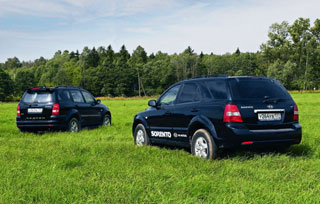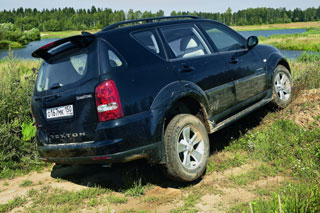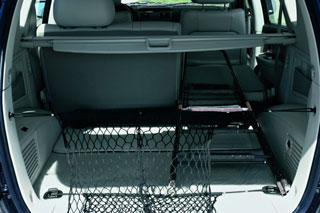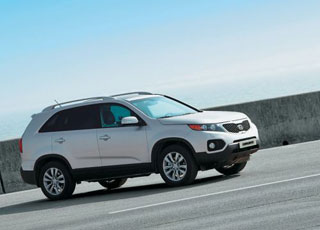Test drive Kia Sorento 2006 - 2009 SUV
Korean syndrome
 Korean machines become better from model to model, from generation to generation, while maintaining their original dignity to the low price. Which also succeeds at the expense of production in our country. Kia Sorento is gathered in Izhevsk at the IL-Avto plant, and Ssangyong Rexton (already with welding and coloring of the body) in Naberezhnye Chelny at the Zma factory.
Korean machines become better from model to model, from generation to generation, while maintaining their original dignity to the low price. Which also succeeds at the expense of production in our country. Kia Sorento is gathered in Izhevsk at the IL-Avto plant, and Ssangyong Rexton (already with welding and coloring of the body) in Naberezhnye Chelny at the Zma factory. It was decided to compare precisely diesel modifications. We considered that, choosing for himself an SUV from Korea, the buyer somehow wants to save, and therefore future fuel economy plays a role. And gasoline versions imply the presence of rather voracious six -willed three liters under the hood. Our assumptions and sales statistics are confirmed: most of the Rexton and Sorento sold in our country with power plants operating on heavy fuel. They do not argue about appearance, as well as about tastes. And we will not argue. We only note that the angular classic silhouette of Kia does not shine with originality, but it looks quite harmonious, but the puffy Ssangyong with a magnificent front-end front and a massive grate of the radiator a la Mercedes is clearly trying to stand out from the total mass of SUVs.
He undoubtedly succeeds, however, at the cost of clearly ambiguous assessments from the general public. These cars are two extremes of the Korean designer school. One is simple and not distinguished by anything, and the second, on the contrary, is too pretentious and pompous. To the correctness of the Japanese, as well as to the subtlety and verification of Europeans, is far far away. Nevertheless, many Russian buyers are enough, and a huge number of Sorento and Rexton, found on our roads, are good to confirm this.
The fact that under the hood of Rexton is a turbodiesel is said by RX270XVT nameplate on the front doors. Kia here is more restrained by no insignia from the gasoline version. The XVT letters mean that the licensed Mercedes diesel, which Ssangyong traditionally equips his models, underwent another modernization and received a variable geometry of the inlet tract and a new turbine. As a result, the power increased to 186 hp, and torque to 402 nm. But the XDI engine (165 hp and 340 nm) remains on the conveyor, which are equipped with simpler modifications.
 Sorento of its own development. This is a 2.5-liter CRD VGT with a Common Rail power system. If a turbodiesel of the same volume developed 140 forces on an SUV of the past generation, then here all 170 hp. Obvious progress! When turning the ignition key, the salons of both machines are filled with a characteristic grunt, although there are almost no vibrations on the controls. And only with a sharp opening of gas on neutrals, both SUVs are shuddering with their whole body displeased. But what should we go out in place, it is time to check the turbodiesel in the case.
Sorento of its own development. This is a 2.5-liter CRD VGT with a Common Rail power system. If a turbodiesel of the same volume developed 140 forces on an SUV of the past generation, then here all 170 hp. Obvious progress! When turning the ignition key, the salons of both machines are filled with a characteristic grunt, although there are almost no vibrations on the controls. And only with a sharp opening of gas on neutrals, both SUVs are shuddering with their whole body displeased. But what should we go out in place, it is time to check the turbodiesel in the case. The KIA engine with a speed set is smoother, and by acoustic sensation is approaching gasoline. But the Ssangyong motor is still tractor rumbling, besides sobbing loudly and whistling a turbine like a truck. And even good sound insulation is not able to drown out this symphony. But gradually you get used to it, and you begin to find even something pleasant in this Sipato voice. On acceleration, both cars go to the nostril. Similar numbers in the acceleration column up to 100 km/h confirm this. The numbers, I must say, are very good for two -ton SUVs. Neither in the city nor on the track there is no shortage of dynamics. But still, Sorento liked it more, or rather his machine gun (they are five -stage for both cars). The predicted, fairly quick switching and constant holding of the tachometer arrows in the most efficient speed range make the traction control very comfortable. The gearbox of the rectona is more attacked, and at high speeds he sins with an unjustified change of gears.
The transmissions of Kia and Rexton II slowly react to Kick Dawn, fingering down the gears for a long time, and have disgusting manual modes. At Ssangyong, you can independently choose steps with an uncomfortable flag on the gearbox lever, or buttons on the steering wheel, and on Kia only a lever, transferring it from the Drive position to the right. Both cars are choked for a second, after thinking, they squat on the back axis, and then an unpleasant jerk with acceleration follows. It is better to limit yourself to the usual Drive mode. At speed up to 120140 km/h, both behave with dignity. They go well in a straight line, almost do not respond to irregularities. Everything is not so rosy in corners. Large gear relations of steering mechanisms make the steering wheel rotate on impressive corners, while telling the driver very little information. If the Sorento steering wheel still allows you to feel the angle of rotation of the front wheels and has almost invisible, but still adequately increasing feedback, then Rexton is completely deprived of this connection, but its steering wheel is better than vibration grounds and impacts are absolutely not felt on it.
 Ssangyong is generally a more comfortable car, not least thanks to better sound insulation and a rich salon. And on the gentle waves, he smoothly lulls his passengers, while Sorento in a similar situation, at a speed of 150 km/h begins to swing up and down with a large amplitude. Strange, especially considering the overall collectiveness of his suspension. Maybe the shock absorbers of the test car have already been made? In any case, there are few people who want to be worn on these SUVs faster than 140 km/h. Because then their main trump cards and smoothness are lost, and also a lack of power is felt. Aerodynamic noises become annoying, the wind howls in the mirrors, cars swim along the road, forcing the driver to be in constant tension. And the brakes are not able to effectively fulfill their function, although there were no complaints about them in the standard modes. Kia brakes were more like. But Ssangyong Long Long Long Long Long Long Long Long Long Long Long Long Long Long Long Long Road Pedal.
Ssangyong is generally a more comfortable car, not least thanks to better sound insulation and a rich salon. And on the gentle waves, he smoothly lulls his passengers, while Sorento in a similar situation, at a speed of 150 km/h begins to swing up and down with a large amplitude. Strange, especially considering the overall collectiveness of his suspension. Maybe the shock absorbers of the test car have already been made? In any case, there are few people who want to be worn on these SUVs faster than 140 km/h. Because then their main trump cards and smoothness are lost, and also a lack of power is felt. Aerodynamic noises become annoying, the wind howls in the mirrors, cars swim along the road, forcing the driver to be in constant tension. And the brakes are not able to effectively fulfill their function, although there were no complaints about them in the standard modes. Kia brakes were more like. But Ssangyong Long Long Long Long Long Long Long Long Long Long Long Long Long Long Long Long Road Pedal. Rexton is very comfortable even on a broken country. But the excessive softness of the suspension sometimes turns into breaks on large irregularities. Sorento, on the contrary, rushes through large bumps with pleasure, the energy intensity is excellent, but shudders on the little things. And the vibrations of the unsubstantiated masses are stronger. Apparently, the presence of a dependent bridge behind, in contrast to an independent suspension on this version of Rexton (XDI modifications still have a monk beam). The all-wheel drive transmissions provided for the test of cars are deprived of any differential locks. The torque is redistributed between the axes automatically (a rigid connection of the front bridge and the locking of the center differ is only on Rexton XDI). Therefore, we did not expect miracles from these crossovers, and even from Kia, despite the presence of a lowering row. They did not happen. Diagonal hanging of cars is not able to withstand. But in order to achieve it, you need to try.
 The impressive passages of pendants and a large angle of crossing the axes allow you to overcome a very serious off -road using the ESP system. Sorento patency is slightly better due to a smaller front overview and a shorter base, even despite the smaller road clearance. In addition, the presence of a demultiplitor allows you to confidently storm the rise, and on the descents is not afraid to divide too much speed. Ssangyong is equipped with a descent system from the mountain, but before it comes into effect, the SUV accelerates to such a speed that it becomes scary. Incomplete. It is better to hold the car with brakes.
The impressive passages of pendants and a large angle of crossing the axes allow you to overcome a very serious off -road using the ESP system. Sorento patency is slightly better due to a smaller front overview and a shorter base, even despite the smaller road clearance. In addition, the presence of a demultiplitor allows you to confidently storm the rise, and on the descents is not afraid to divide too much speed. Ssangyong is equipped with a descent system from the mountain, but before it comes into effect, the SUV accelerates to such a speed that it becomes scary. Incomplete. It is better to hold the car with brakes. Who are the buyers of Sorento and Recton? Marketers believe that these are mainly middle -aged men, with a family who are ready to sacrifice the acuteness of management in favor of comfort, practicality and versatility. It is difficult to disagree with them. Moreover, all this can be safely added to such important things as an acceptable price and good quality of modern Korean cars. Ah design! Here, choose yourself either to be a gray mouse on Sorento, or to flaunt the eclectic physiognomy of renovation. I don't like the same? Pull money for an advanced European
History
The current Kia Sorento and Ssangyong Rexton fruit of modernization and restyling of the same models that appeared in 2002. In addition to external changes, the Sorento turbodiesel engine has become more powerful by 30 forces (170 instead of 140 hp), and the new modification of the XVT of the Rexton II engine is already developing 186 hp. Unlike 165 hp Version XDI. All previous renovations had a rear dependent suspension (bridge) and a handout with a lowering nearby.
Dmitry Krotov






A source: Motor magazine [October 2008]










